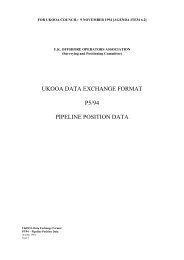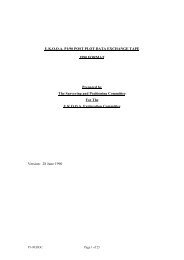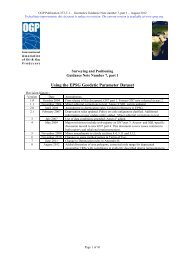1065 - OGP Surveying and Positioning Committee
1065 - OGP Surveying and Positioning Committee
1065 - OGP Surveying and Positioning Committee
You also want an ePaper? Increase the reach of your titles
YUMPU automatically turns print PDFs into web optimized ePapers that Google loves.
Annex G____________________________________________________________________________________________________________Page G1Annex G - Glossary7-parameter transformation: See Helmert transformationBritish National Grid: see National Grid.Common Offshore transformation: An operation using the position vectortransformation method <strong>and</strong> a specified set of Helmert transformation parameters forchanging co-ordinates between the WGS 84 <strong>and</strong> ED50 co-ordinate systems in the UKCSNorth Sea, English Channel, <strong>and</strong> Irish Sea. For petroleum exploration <strong>and</strong> productionpurposes the transformation can also be used between the ETRF89 <strong>and</strong> ED50 co-ordinatesystems.“Common Offshore” transformation parameters from ETRF89 (WGS 84) to ED50dX(m) dY(m) dZ(m) RotX" RotY" RotZ" Scale(ppm)+89.5 +93.8 +123.1 0 0 +0.156 -1.200Test Point using Common Offshore transformation parameters :Latitude Longitude Ellipsoid HeightETRF89 (WGS 84) 53° 00' 00.000" N 01° 00' 00.000" E 50.00 mED50 53° 00' 02.887" N 01° 00' 05.101" E 2.72 mco-ordinate system: A general term for the geometric framework with respect to whichplaces can be given unique co-ordinates. These co-ordinates might be latitude <strong>and</strong> longitude,or X, Y <strong>and</strong> Z cartesian co-ordinates. A co-ordinate system must be realised by surveyingto be useful, <strong>and</strong> is therefore subject to error. Co-ordinates given for a point are valid onlywithin the extent <strong>and</strong> accuracy of the stated co-ordinate system. Because co-ordinatesystems are realised by different survey methods, their region of application <strong>and</strong> accuracyvaries widely. The relevant co-ordinate systems here are ED50, ETRF89, British NationalGrid, Irish National Grid <strong>and</strong> WGS 84.datum: a reference surface for a co-ordinate system. See geodetic datum.ED50: European Datum of 1950, a co-ordinate system based on a geodetic datum of thesame name covering mainl<strong>and</strong> western Europe, derived from traditional theodolitetriangulation networks. ED50 is the unambiguous term for the original co-ordinate set of theEuropean Datum. Because of distortions in the ED50 system, accurate extrapolationoffshore is impossible. Inaccuracies increase with distance from mainl<strong>and</strong> western Europe.Uncertainty in establishing ED50 offshore varies from 2 metres in the southern North Sea toseveral hundred metres in the Atlantic margins. The uncertainties of establishing EuropeanDatum in the Atlantic margins would be unacceptable where petroleum reserves straddlelicence boundaries.ellipsoid: The simple geometric shape used as a model of the shape of the earth. Manyellipsoids exist to suit different regions of the earth. Those encountered on the UKCS includethe Airy 1830 ellipsoid which is used by the British National Grid <strong>and</strong> has a semi-major axisof 6377563.396 metres <strong>and</strong> inverse flattening of 1/299.32496; the Airy modified 1849ellipsoid which is used by the Irish National Grid <strong>and</strong> has a semi-major axis of 6377340.189metres <strong>and</strong> inverse flattening of 1/299.32496; the International 1924 ellipsoid which is usedby the ED50 co-ordinate system <strong>and</strong> has a semi-major axis of 6378388.0 metres <strong>and</strong> inverseflattening of 1/297.0; the GRS80 ellipsoid which is used by the ETRF89 co-ordinate system<strong>and</strong> has a semi-major axis of 6378137.0 metres <strong>and</strong> inverse flattening of 1/298.25722; <strong>and</strong>the WGS84 ellipsoid which is used by the WGS 84 co-ordinate system <strong>and</strong> like GRS80 hasa semi-major axis of 6378137.0 metres <strong>and</strong> inverse flattening of 1/298.25722._____________________________________________________________________________________________UKOOA Guidance Notes on use of co-ordinate systems in data management on the UKCS - December 1999






